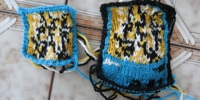Knitted studies
2009
Type
Knit
Keywords
knit, fibre, wool, pixels, grid
These images are all studies for future works, none of which are complete. They each explore the relationship of knitting and the grid.
The first is an animation of a glider from Conway's Game of Life. "Game" is somewhat of a misnomer; it is a mathematical construction that illustrates how complex behaviour can arise from simple rules. Each "cell" in The Game of Life is evaluated according to the presence of its neighbouring active cells. If there are too many adjacent cells that are active, an active cell dies. If there are too few adjacent cells that are active, the cell also dies. Otherwise, the cell lives.
This deceptively simple set of rules creates surprisingly complex behaviour. The most famous of these known behaviours is the glider, a shape that appears to wiggle across the grid like a simple organism.
For this animation, each frame of the movement of a glider was knitted into swatches. Why knit the Game of Life? The presence of the grid in both systems is hard to miss, but there is something quietly revolutionary about knitting The Game. The Game of Life only makes sense thanks to computers. The complex behaviour would not be observable without a machine to compute the frames quickly. By knitting The Game's frames, the computation is being slowed to a barely perceptible crawl.
As in the animation, the second image is also from The Game of Life. Perhaps one of the other most famous shapes is the Gosper glider gun. This image is of the first frame of a thirty-frame animation of the gun. The gun is a shape that, each iteration, actually creates gliders that swim off into infinity, across the grid. Two gliders can be seen wiggling their way towards the bottom-right corner. The name "gun" for a structure that gives birth to gliders is a beautiful contradiction, and the knitting of the gun is birth slowed down to practically a geological timescale.
The third image is a complete recreation of the opening screen of the Commodore 64, the computer that defined the 1980s.
The fourth image is of two test swatches for the Sticks and Stones performance. The performance plays out the ancient Chinese board game Go with no board. Rather, a new swatch is made for each move. Go also provides an interesting opportunity to observe the grid. Once again, the pace of a game is slowed down by knitting. Each move must wait for the knitting of the previous. There is also a curious connection between Go and knitting: a previous name for Go translates as "hand conversation"—perhaps fitting for knitting.



